
Edward Winter

See C.N. 4479 below.
From Capablanca on Maróczy:
‘Concerning the relative strength of Maróczy and the best young masters of today, my opinion is that, with the exception of Botvinnik and Keres, Maróczy in his time was superior to all the other players of today.
If it is appreciated that in 1900 Maróczy was one of the world’s top players and that 30 years later he was still capable of giving the champion of Hungary such a tremendous beating, it must be agreed that to compare another player with him a similar performance will be necessary over a more or less identical period. This brings us to the question of whether today’s players are as strong as, or more strong than, the players of 30 years ago.
The modern players believe that they know more and are stronger than the players of 30 years ago. In my opinion, this is a major error. A group of players like Tarrasch, Schlechter, Maróczy, Rubinstein, Lasker and I, as we were 30 years ago, does not exist today, and I do not think it has ever existed. Moreover, it should be borne in mind that I have not mentioned Bernstein, Marshall, Důras, Vidmar, Teichmann, Janowsky, Nimzowitsch, Spielmann and Tartakower, all of whom won important tournaments and matches.’
Regarding the ‘Argentine Variation’ in the 1927 Capablanca v Alekhine match (see Chess Jottings), Maróczy played 9 Bh4 over 20 years before the Buenos Aires match. One of Daly’s handwritten game-scores sent to us by Richard Lappin (Jamaica Plain, MD USA) – i.e. not in the Lyman/Dann book on Daly – is the following:
Géza Maróczy – Harlow Bussey Daly
Boston, 4 April 1906
Queen’s Gambit Declined
1 d4 d5 2 c4 e6 3 Nc3 Nf6 4 Bg5 Nbd7 5 e3 c6 6 Nf3 Qa5 7 Nd2 Bb4 8 Qc2 O-O 9 Bh4 Ne4 10 Ndxe4 dxe4 11 Be2 e5 12 O-O f5 13 c5 exd4 14 exd4 Nf6 15 Bc4+ Kh8 16 Ne2 Bd2 17 Rad1 Bh6 18 f3 Bd7 19 Bxf6 exf3 20 Be5 fxe2 21 Qxe2 Bg5 22 a3 Rae8 23 Qd3 Bf6 24 Bd6 Be7 25 Bg3 Bg5 26 Rde1 Qd2 27 Rxe8 Rxe8 28 Qxd2 Bxd2 29 Be5 Be3+ 30 Kh1 h6 31 h3 Kh7 32 g4 f4 33 Kg2 Be6 34 Bxe6 Rxe6 35 Kf3 g5 36 Ke4 Kg6 37 b4 Kf7 38 a4 a6 39 b5 axb5 40 axb5 Re8 41 bxc6 bxc6 42 Rb1 Bf2 43 Kf5 Bh4 44 d5 cxd5 45 c6 f3 46 Rb7+ Re7 47 Rb1 f2 48 c7 Re8 49 Rf1 Rc8 50 Bd6 Ke8 51 Ke6 d4 52 Be5 d3 53 Kd6 Ra8 54 Kc6 Rc8 55 Rd1 Ke7 56 Kb7 Resigns.
This fine game may not have appeared in print before.
(1536)
The Maróczy game was played at the Boston Chess Club, the master’s score being +15 –5 =4 (American Chess Bulletin, May 1906, page 85).
(1600)
‘It is generally the shortcoming of a young player that he does not keep abreast of the theory of the game.’
Géza Maróczy, American Chess Bulletin, October 1906, page 212.
(1747)
Dawid Janowsky- Géza Maróczy
Munich, 27 July 1900
Albin Counter-Gambit
1 d4 d5 2 c4 e5 3 dxe5 d4 4 e4 Nc6 5 Bf4 Nge7 6 Bg3 h5 7 h3 g5 8 h4 g4 9 Nd2 Ng6 10 f4 Be7 11 Bd3 Nxh4 12 Qe2 Ng6 13 e6 h4 14 Qxg4 Bxe6 15 f5 Bc8 16 Bh2 Nge5 17 Qe2 Nxd3+ 18 Qxd3 Nb4 19 Qb3 a5 20 Nh3 a4 21 Qd1 Nd3+ 22 Kf1 Nxb2 23 Qg4 Ra6 24 Nf4 Kf8 25 Nd5 Rc6 26 Be5 Rg8 27 Qh5 Bg5 28 Nf3 Nxc4 29 f6 Ne3+ 30 Nxe3 Bxe3 31 Rd1 Bg4 32 Qxh4 Bxf3 33 gxf3 Rc2 34 Bxd4 Qa8

35 Rd3 Qa6 36 White resigns.
The Munich, 1900 tournament book (page 50) gives the conclusion of the game as 35 Rd3 Qa6 36 White resigns, but a few other sources have mistakenly claimed that Janowsky won in brilliant style. The earliest we know of is P. Wenman’s One Hundred Chess Gems (first published in 1939). On pages 42-43 he affirmed that the finish had been 35 Ba7 Bxa7 36 Qh6+ Ke8 37 Qg7 Rf8 38 Qxf8+ Kxf8 39 Rh8 mate. Wenman also gave that fictitious conclusion on page 75 of Learn to Play Chess (1946). See CHESS, April 1953, page 126 and May 1953, page 151 for further details, as well as the September 1979 issue of the Australian magazine Chess Player’s Quarterly (pages 69 and 71), which has an article entitled ‘The Game That Never Was’ by Mike Winslade.
Was Wenman (described by The Companion as ‘the problem world’s most notorious plagiarist’) the first to tamper with the Janowsky-Maróczy game and if so was it an isolated offence in his game anthologies?
One Hundred Chess Gems is a curious work. Whereas Capablanca’s play is featured only once (his loss to Lilienthal), there are two games by Wenman himself (a win and a draw in the battle for supremacy at ‘the Bristol and Clifton Club Championship’).
Wenman churned out many books which, despite (?) the bad contents, had good sales and gained him a certain amount of fleeting fame. But by the time he died, in 1972, he had been consigned to oblivion and was ignored by the obituarists. A cautionary tale.
(1652)
Wanted: information about the origins of the Maróczy Bind. One of the few writers to venture a precise game reference is Andrew Soltis. Pages 97-98 of his Pawn Structure Chess claim that ‘the first master game to gain recognition of the Bind was Swiderski v Maróczy, Monte Carlo 1904, in which Maróczy, with Black in a Dragon formation, was the “bindee” rather than the “binder”. It was his opponent who played P-QB4 and P-K4. But for years later Maróczy, a great Hungarian grandmaster and chess journalist, repeatedly drew attention to the powers of the Bind, and, by the 1920s, permitting the Bind was equated with making a blunder.’
The quoted Swiderski Bind actually arose through transposition; the opening moves were 1 e4 c5 2 c4 Nc6 3 Nf3 g6 4 d4 cxd4 5 Nxd4 Bg7 6 Be3 Nf6 7 Nc3 d6 8 Be2 Bd7 9 O-O O-O, and subsequent imprecision by White gave Maróczy the game in 48 moves. Around this time, an early c4 by White in the Sicilian was being linked to Maróczy’s name (e.g. Wiener Schachzeitung, October 1906, page 348), but it is far from easy to trace early specimens of the Maróczy Bind, played either by G.M. himself or by other masters.
(Kingpin, 1992)
An addition on page 148 of Kings, Commoners and Knaves:
Page 79 of the March-April 1906 Wiener Schachzeitung reproduced from Magyar Sakklap Maróczy’s annotations to the 16th match-game between Tarrasch and Marshall at Nuremberg, November 1905 (which began 1 e4 c5 2 d4 cxd4 3 Nf3 a6 4 Nxd4 g6 5 Be2 Bg7 6 Nc3 Nc6). On four consecutive moves (3-6) Maróczy stressed the value of the move c4.
John Blackstone (Las Vegas, NV, USA) has found that the game discussed in C.N. 8541 is the second of two victories by Solomon Rubinstein published by Hermann Helms on page 9 of the Brooklyn Daily Eagle, 6 May 1906:


The Meyer v Rubinstein game (1 e4 c5 2 Nf3 Nc6 3 d4 cxd4 4 Nxd4 g6 5 Be3 Bg7 6 c4 d6 7 Nc3 Nf6 8 Be2 Bd7 9 O-O Nxd4 10 Bxd4 Bc6 11 f3 O-O 12 b4 b6 13 a4 a5 14 b5 Bb7 15 Rc1 Nd7 16 Bf2 Qc7 17 Nd5 Bxd5 18 cxd5 Nc5 19 Bxc5 dxc5 20 f4 Rac8 21 e5 f6 22 Bc4 Kh8 23 e6 f5 24 h4 Bd4+ 25 Kh1 Rf6 26 h5 gxh5 27 Qxh5 Qd8 28 Rf3 Qf8 29 Rh3 Qg7 30 Rc2 Rg6 31 Bd3 Be3 32 Qxf5 Qa1+ 33 White resigns) is of relevance to the discussion on the origins of the Maróczy Bind on pages 147-148 of Kings, Commoners and Knaves.
(8544)
Further to C.N. 8544, Mr Blackstone sends the Maróczy v Voigt exhibition game mentioned by the Brooklyn Daily Eagle, from the supplement section of the Los Angeles Herald, 29 April 1906:
Géza Maróczy – Hermann G. Voigt
Philadelphia, 1906
Sicilian Defence
1 e4 c5 2 d4 cxd4 3 Nf3 g6 4 Nxd4 Bg7 5 c4 Nf6 6 Nc3 d6 7 Be2 O-O 8 Be3 Bd7 9 O-O Nc6 10 h3 Nxd4 11 Bxd4 Bc6 12 Bf3 Re8 13 b4 b6 14 a4 Rc8 15 a5 Qc7 16 axb6 axb6 17 Ra6 Nd7 18 Bxg7 Kxg7 19 Qa1 Ne5 20 Ra7 Qd8 21 Be2 Bd7 22 Nd5 Kg8 23 Rc1 e6 24 Ne3 h5 25 b5 Qh4 26 Rd1 Qf4 27 g3 Qh6 28 Rxd6 Resigns.
We add that brief notes by Maróczy were published on page 76 of the April 1906 American Chess Bulletin. After 5 c4 he wrote:
‘This continuation has been emphatically recommended by me. P-Q4 is no longer possible to Black and he obtains a cramped game.’
(8545)
Eduardo Bauzá Mercére (New York, NY, USA) notes that when the Maróczy v Voigt game given in C.N. 8545 was published on page 2 of the Philadelphia Inquirer, 29 April 1906, the following assertion came after 1 e4 c5 2 d4 cxd4 3 Nf3 g6 4 Nxd4 Bg7 5 c4:
‘This is Mr Maróczy’s new move, and he is so sure that it gives White a great advantage that he offered to give Dr Tarrasch five games out of ten if the doctor would play the variation taking the black pieces. The doctor, however, declined.’
(9901)
A straightforward and effective illustration of unthinking mobilization is the following game, won by Géza Maróczy during a tour of the United States:
Géza Maróczy – Mordecai Morgan
USA, 1906
Ruy López
1 e4 e5 2 Nf3 Nc6 3 Bb5 a6 4 Ba4 Nf6 5 O-O Be7 6 Re1 b5 7 Bb3 O-O 8 c3 d6 9 d4 Bg4 10 a4

10...Rb8 (‘A decisive mistake. Black was playing mechanically and making the book moves without realizing the actual change in the position, a pawn being at c3 instead of knight’ – Maróczy.) 11 axb5 axb5 12 d5 Resigns.
Source: American Chess Bulletin, April 1906, page 76.
Maróczy is also the winner of the next game, which demonstrates how the bishop pair can dominate two knights. The brief notes are by the Hungarian himself:
Morgan Smith – Géza Maróczy
Winnipeg, 1906
Sicilian Defence
1 e4 c5 2 Nf3 e6 3 d4 cxd4 4 Nxd4 Nf6 5 Bd3 Nc6 6 Nf3 (‘More natural is 6 Be3.’) 6...Qc7 7 Nc3 a6 8 Ne2 Be7 9 O-O O-O 10 Bf4 d6 11 Ng3 Bd7 12 c3 Ne5 13 Kh1 (‘Losing a pawn and the game. 13 Bc2 was his best. Black is well developed, having overcome the opening difficulties. Either 13 Bxe5 or 13 Nxe5 by White would be inferior.’) 13...Nxd3 14 Qxd3 Bb5 15 c4 Qxc4 16 Qxc4 Bxc4 17 Rfc1 Rac8 18 Rd1 d5 19 Nd2 dxe4 20 Ndxe4 Bd5 21 Nc3 Rfd8 22 h3 Bc6 23 Rxd8+ Rxd8 24 Rd1 Rxd1+ 25 Nxd1 Nd5

(‘The ensuing ending is very instructive and well demonstrates the strength of two bishops.’) 26 Bd2 f5 27 Ne2 e5 28 Kg1 Kf7 29 Ne3 Ke6 30 Nc3 Nf4 31 Kf1 b5 32 a3 g5 33 f3 h5 34 Na2 Bc5 35 Nb4 Bb7 36 Nec2 a5 37 Bxf4 gxf4 38 Na2 Bd5 39 Nc3 Bc4+ 40 Ke1 b4 41 axb4 axb4 42 Na4 Kd5 43 Kd2 Bf1 44 Ne1 Be3+ 45 Kd1 Kc4 46 Kc2 b3+ 47 Kd1 Bd4 48 Kd2

48...h4 49 White resigns.
Source: American Chess Bulletin, May 1906, page 86.
Albert Frank (Brussels) asks if precise facts are available about the Maróczy v Korchnoi ‘spiritualist story’. We touched on it in C.N. 5162 (regarding a sideline: the spellings Romi/Romih), but does any reader know where the essentials of the affair have been set out, plainly and factually? And when did any mention of Maróczy v Korchnoi first appear in print?
(5411)
Alejandro Pablo Souto (Buenos Aires) reports that the Maróczy v Korchnoi ‘spiritualist’ game was the subject of a feature on page 23 of the November 1988 Revista Internacional de Ajedrez. It quoted a Reuters dispatch from Reykjavik which had appeared in El País of 6 October 1988 and included a report on statements allegedly made by Korchnoi to the Icelandic daily newspaper Tíminn.
On the same page of the Revista Pablo Morán made a few light comments and gave the game-score up to Black’s 27th move.

(5417)
We are grateful to Baldur Fjölnisson (Reykjavik) for sending those reports:

5 October 1988, page 1, page 5. 6 October 1988, page 5.
Mr Fjölnisson comments:
‘In the interview Korchnoi does not really say much about the game. Interestingly though, he states that Maróczy dropped a piece in the middle-game, which contradicts the game-score as widely published. Otherwise the story is broadly in line with accounts available on the Internet. At the time, in 1988, 30 moves had been played according to Korchnoi.’
(7262)
In Liz Garbus’s 2011 documentary film Bobby Fischer Against the World Anthony Saidy asserted:
‘Victor Korchnoi claimed to have played a match with a dead man and he even provided the moves.’
(7345)
In the early 1980s Daniël De Mol (Wetteren Belgium) bought from Szabó a book by Géza Maróczy, Végjátékok és Játszmák (published by Pantheon Kiadás, undated – but apparently during the Second World War). Our correspondent has been unable to find other references to the book.
Is it known to readers? Our own collection contains several books by Maróczy in Hungarian, but not that one.
(2290)
Owen Hindle (Cromer, England) informs us that he has a copy of the Maróczy book. The 370-page volume A Modern Sakk Vezérkönyve was in three parts; the third of them (pages 235-370) being the work discussed in C.N. 2290.
Brian Karen (Levittown, NY, USA) asks for particulars about the tour by Maróczy mentioned on page 103 of The Fireside Book of Chess by I. Chernev and F. Reinfeld (New York, 1949):
‘Playing simultaneously in Europe from June 1927 to March 1928, Geza Maroczy compiled the almost incredible score, from a total of 943 games, of 825 wins, 113 draws and only 5 losses.’
Chernev gave the same brief item on page 56 of Curious Chess Facts (New York, 1937) and page 74 of Wonders and Curiosities of Chess (New York, 1974). The tour of Hungary by Maróczy, who was in his late fifties, was sparsely reported by magazines, but page 107 of the April 1928 Wiener Schachzeitung gave a complete chart of the 21 displays. In 17 of them Maróczy was undefeated, and the largest number of boards he faced was 81. That was in the first séance (Szeged, 18 June 1927), where his score was +69 –0 =12.

Géza Maróczy
(3906)
Marek Soszynski (Birmingham, England) mentions that page 70 of a book he co-authored with Jan Przewoznik, How to Think in Chess (Milford, 2001), noted John Nunn’s term ‘collinear move’, while page 234 suggested that the following example of ‘collinearity’ was possibly ‘the move of the book’:
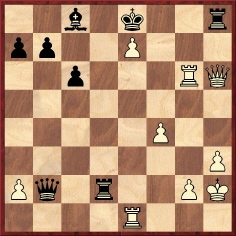
G. Maróczy v M. Romi, San Remo, 25 January 1930
White played 41 Qh5 and won.
(4233)
Michael Clapham (Ipswich, England) reports that he recently acquired this photograph of Géza Maróczy:

Our correspondent wonders whether the ‘old English’ chess pieces provide a clue concerning the occasion. In this connection, we note the framed portrait of Amos Burn on the far left
(4479)
A group photograph from page 173 of the December 1925 American Chess Bulletin:

(4992)
This Nice, 1930 group photograph was published on page 68 of the April 1930 American Chess Bulletin:
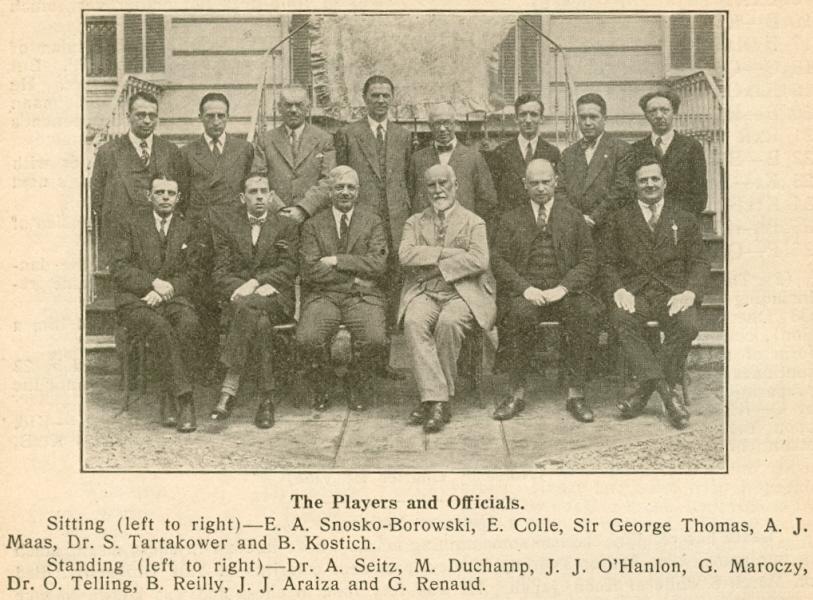
(5319)
The ‘Changing the Rules’ chapter of our Capablanca book also discussed Double Chess, and we had the pleasure of transcribing this game from pages 323-324 of the November 1929 issue of Magyar Sakkvilág:


The photograph below of Capablanca and Maróczy in play was published on page 53 of Alt om Skak by B. Nielsen (Odense, 1943):

(5619)
C.N. 5619 showed a game of Double Chess between Maróczy and Capablanca on pages 323-324 of the November 1929 issue of Magyar Sakkvilág. The game-score was also on page 197 of L’Echiquier, May 1929:

(10446)
From our archives:


The article’s exact original appearance in the Evening Standard newspaper is not currently to hand.
A contribution from Olimpiu G. Urcan:

The Times, 12 April 1929, page 18.
(8178)
Ignacio Raviolo (Rafaela, Argentina) asks whether the lesser-known writings of Géza Maróczy (i.e. mainly in Hungarian books) contain any particularly notable or quotable passages that deserve wider currency.
(5678)

Carlos Torre and Géza Maróczy, Chicago, 1926 (American Chess Bulletin, November 1926, page 140)
(5767)
C.N. 6119 gave this extract from pages xix-xx of the Preface by Benjamin M. Anderson Jr to Capablanca’s A Primer of Chess (New York, 1935):


The passage was discussed in C.N.s 706 and 1177 (see pages 117-118 and 263 of Chess Explorations), as well as C.N. 6118. For the game in question we can still offer only one candidate: Marshall v Maróczy, Lake Hopatcong, 1926. (As mentioned in C.N. 5991, Anderson was in Lake Hopatcong at the time.) The game began 1 e4 e6 2 d4 d5 3 Nc3 Nf6 4 e5 Nfd7 5 Qg4 c5.
The Endnote on page 263 of Chess Explorations:
C.N. 1177: ‘This incident was reported in the Cuban magazine Jaque Mate 2-3/1971 (page 85), where it was claimed (on what basis?) that 3 Nd2 was played. That would exclude the Lake Hopatcong game, but we feel it is more likely that Jaque Mate is wrong.’
On page 293 of his Marshall book, Soltis stated categorically, without indicating his source, that Maróczy’s long thought was indeed against Marshall at Lake Hopatcong, 1926.
An item about Géza Maróczy on page 26 of the February 1929 American Chess Bulletin:
‘Only recently the famous Hungarian sent out as a Christmas greeting card to his wide circle of friends the score of the Muzio Gambit which he won from Chigorin in the Vienna Gambit tournament of 1903.’
The game is well known, but does any reader have the greeting card?
Below is the best photograph of Maróczy in our collection:
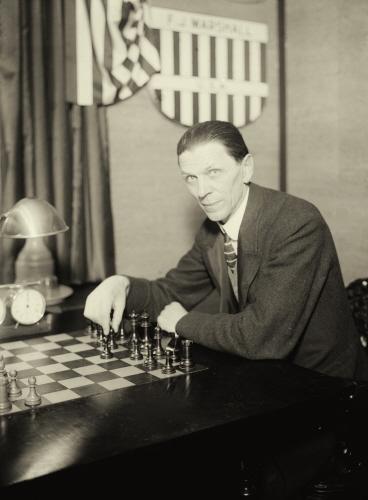
(6922)
David DeLucia (Darien, CT, USA) sends a copy of Maróczy’s card:

(6928)
A game ‘played in order to test a particular variation 3...P-QKt4’:
Leonard Percy Rees – Géza Maróczy1 d4 e6 2 c4 c5 3 d5 b5

4 b3 Bb7 5 dxe6 fxe6 6 Bb2 d5 7 cxb5 Nf6 8 e3 Bd6 9 Bd3 O-O 10 Nf3 Nbd7 11 O-O e5 12 e4 d4 13 Nbd2 Qe7 14 Qe2 Nh5 15 g3 g5 16 Nc4 Bc7 17 a4 Rae8 18 Rae1 Ng7 19 Bc1 h6 20 a5 Bc8 21 Ba3 Qf6 22 Nfd2 Qg6 23 b4 cxb4 24 Bxb4 Rf7 25 Nb3 Ne6 26 Bd6 Bxd6 27 Nxd6

27...Nf4 28 Qa2 Nxd3 29 Nxe8 Nxe1 30 Rxe1 Nf8 31 Nc5 Bg4 32 Qd5 Ne6 33 Nd7 Nc7 34 Nef6+ Kg7

35 Qxe5 Rxf6 36 Nxf6 Qxf6 37 Qxc7+ Kg6 38 e5 Qe6 39 b6 axb6 40 axb6 d3 41 b7 d2 42 Rb1 Qb3 43 Qc6+ Kf5 44 Qd7+ Resigns.
Sources: CHESS, 14 October 1938, pages 55-56, and BCM, February 1945, pages 32-33.
CHESS reported:
‘Not so long ago, on a certain summer’s day in 1922, Mr Rees met, at the City of London Chess Club, the Hungarian master Maróczy, who asked him his opinion of the “Wing Gambit” or “Blumenfeld counter-gambit” in the Benoni opening. The question led to their sitting down and playing a serious game in which the master was decisively beaten ... It is hardly possible to suggest any improvement to Mr Rees’s play throughout.’
(7247)
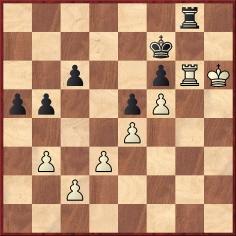
Black to move
Should Black play 39...Rxg6+ and then create a passed pawn on the queen’s side? It has been suggested that this is what Géza Maróczy did in a game against Adolf Zinkl, thereby overlooking a mate in one in the diagrammed position.
From page 366 of CHESS, 14 June 1937:

Below is the relevant part of pages 5-6 of Reinfeld’s Instructive and Practical Endings from Master Chess. Lesson I: Rook and Pawn Endings (New York, 1937):


Our copy has an erratum slip:

The conclusion of the game was given on page 67 of L. Bachmann’s Schachmentor (Ansbach, 1904):

In reality, Zinkl v Maróczy (played in December 1899 in the Second Kolisch Memorial Tournament in Vienna, 1899-1900) ended 38 Kh5 Rg8 39 White resigns. The full game: 1 e4 e5 2 Nf3 Nc6 3 Bc4 Bc5 4 d3 Nf6 5 Be3 Bxe3 6 fxe3 d6 7 Nc3 Na5 8 Bb3 O-O 9 Qe2 Nxb3 10 axb3 c6 11 O-O Ng4 12 h3 Nh6 13 g4 f6 14 Qg2 Nf7 15 Kh2 d5 16 Rg1 g6 17 Raf1 Be6 18 Qf2 Kg7 19 Rg3 h6 20 h4 dxe4 21 Nxe4 Bd5 22 Nfd2 Bxe4 23 Nxe4 Nd6 24 Nxd6 Qxd6 25 e4 Qd4 26 Qf3 Qxb2 27 Rf2 Qd4 28 h5 Qd7 29 hxg6 Qe8 30 Qf5 Qxg6 31 Rg1 Qxf5 32 gxf5+ Kf7 33 Rfg2 Rg8 34 Rg6 Rxg6 35 Rxg6 Rh8 36 Kh3 a5 37 Kh4 b5 38 Kh5

38...Rg8 39 White resigns.
Sources: pages 110-111 of the April 1900 Deutsche Schachzeitung and, as shown below, page 187 of Igy kezdtem ... by G. Maróczy (Budapest, 1942):

Thus Maróczy committed no oversight. The hypothetical mate in one (39 Kxh6 Rh8) was missed by L. Hoffer when he annotated the game in the 13 January 1900 issue of The Field. After 38...Rg8 he wrote:
‘A very pretty move. If 39 K takes P, then 39...R takes R ch wins ...’
Hoffer’s notes were reproduced on pages 37-38 of Vienna 1899/1900 edited by A.J. Gillam (Nottingham, 2008) without mention of the missed mate in one.
(8858)
C.N. 8858 gave this extract from page 67 of Ludwig Bachmann’s Schachmentor (Ansbach, 1904):

The missed mate in one (39 Kxh6 Rh8) can also be found on page 61 of another work by Bachmann which has the identical text:

We have that book under two titles, Schach durch Selbstbelehrung u. Selbstunterricht (Berlin, 1929) and Schach Praktisches Lehrbuch (Berlin, undated). The respective title pages specified ‘23. Auflage’ and ‘25. Auflage’.
(8985)
An item contributed by Olimpiu G. Urcan (Singapore):
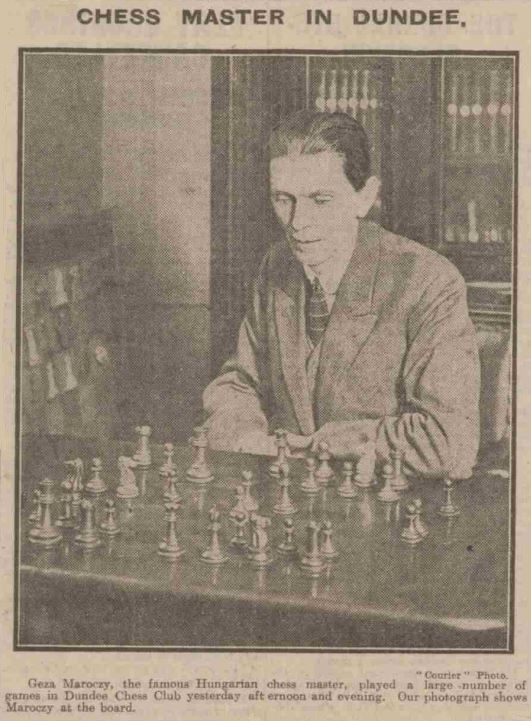
Dundee Courier, 11 December 1924, page 3.
(8960)
An addition to The 1936 Munich Chess Olympiad is this photograph on page 60 of Deutsche Schachblätter, 1 April 1940:

An autobiographical note by Maróczy was on page 69 of the 1 May 1940 issue:
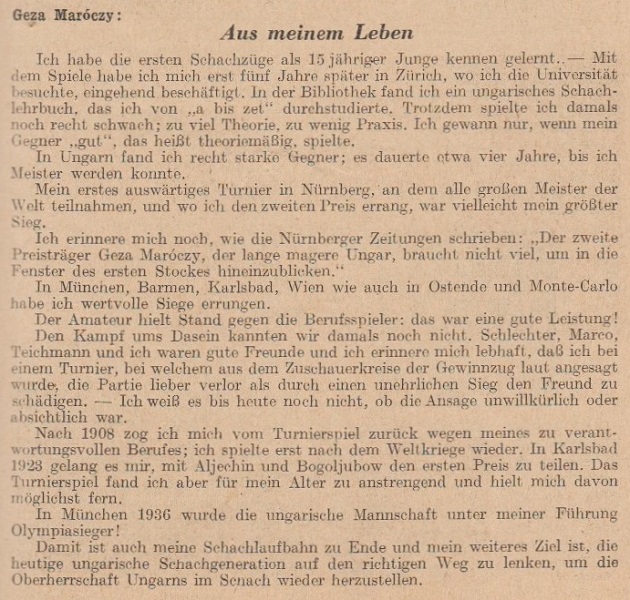
(9841)
From the Detroit Free Press (Rotogravure Supplement), 23 March 1924:

From left to right: Efim Bogoljubow, Géza Maróczy, Richard Réti, Emanuel Lasker, Savielly Tartakower
(10189)

White to move
From page 10 of Chess Review, January 1952 in an article by Tartakower entitled ‘From My Chess Memoirs’:

The episode was also referred to by Albéric O’Kelly de Galway on page 266 of the September 1956 Chess Review:
‘Bernstein narrates the following concerning his game against Maróczy. In a desperate position and about to resign, he saw that his opponent had only 30 seconds for three moves to the time-limit, while he himself had half an hour. Knowing a normal move must lose quickly, he suddenly made a move which was rather stupid. As he expected, his opponent was caught by surprise, flushed nervously, overlooked the winning move and lost.’
The Bernstein v Maróczy game: 1 d4 d5 2 c4 e6 3 Nc3 Nf6 4 Nf3 Be7 5 Bf4 O-O 6 e3 b6 7 cxd5 exd5 8 Bd3 a6 9 O-O Bb7 10 Ne5 c5 11 Qf3 Ra7 12 Rad1 c4 13 Bb1 b5 14 e4 dxe4 15 Nxe4 Nbd7 16 Nc6 Bxc6 17 Nxf6+ Nxf6 18 Qxc6 Qd5 19 Qb6 Rd7 20 Rfe1 Bb4 21 Bd2 Bd6 22 Qa5 Qxd4 23 Bc3 Bxh2+ 24 Kxh2 Ng4+ 25 Kh1 Qxd1

26 f3 Qd5 27 fxg4 Rd6 28 Qc7 b4 29 Be4 Rh6+ 30 Kg1 Qb5 31 Bd2 Re6 32 Bf3 Rfe8 33 Rxe6 Resigns.
The game was annotated on pages 69-71 of Moderne Schachstrategie (Breslau, 1930), a monograph on Bernstein by Tartakower.
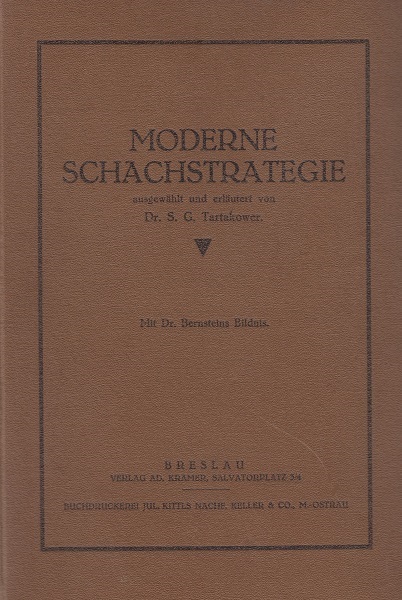



Other notes can be found on pages 395-400 of the Caissa Editions book on Ostend, 1906 edited by A.J. Gillam (Yorklyn, 2005), and a computer-check of the game will be found particularly valuable. A curiosity is that on page 177 of the June 1952 BCM E.G.R. Cordingley stated that the game was drawn.
(10300)

Position after 26 f3
From Peter Anderberg (Harmstorf, Germany):
‘According to W.A. Földeák in the 18/1967 issue of Schach-Echo, pages 285-286, Maróczy refrained from playing 26...Re8 because H. Wolf, who was standing in the crowd of onlookers, had audibly but inadvertently mentioned the possibility of that winning move.’
On pages 284-286 Schach-Echo gave the full game with Maróczy’s annotations translated from Hungarian into German. Below is the conclusion and Földeák’s afterword.


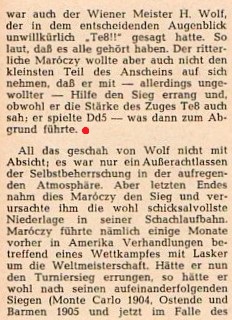

(10326)
Eduardo Bauzá Mercére sends three games played by Géza Maróczy, against C.E. Norwood, S.S. Cohen and H. Steiner, in the 1925-26 Manhattan Chess Club Championship in New York:
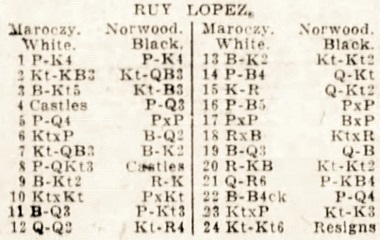
Brooklyn Daily Eagle, 21 January 1926, page 4A
1 e4 e5 2 Nf3 Nc6 3 Bb5 Nf6 4 O-O d6 5 d4 exd4 6 Nxd4 Bd7 7 Nc3 Be7 8 b3 O-O 9 Bb2 Re8 10 Nxc6 bxc6 11 Bd3 g6 12 Qd2 Nh5 13 Be2 Ng7 14 f4 Qb8 15 Kh1 Qb7

16 f5 gxf5 17 exf5 Bxf5 18 Rxf5 Nxf5 19 Bd3 Qc8 20 Rf1 Ng7 21 Qh6 f5 22 Bc4+ d5 23 Nxd5 Ne6 24 Nb6 Resigns.

New-Yorker Staats-Zeitung, 14 March 1926, page 7D
1 e4 e5 2 Nf3 Nf6 3 Nxe5 d6 4 Nf3 Nxe4 5 c4 Be7 6 Nc3 Nf6 7 d4 d5 8 Bg5 dxc4 9 Bxc4 O-O 10 h3 c6 11 O-O h6 12 Bf4 Bf5 13 Re1 Nbd7 14 d5 cxd5 15 Nxd5 Bc5

16 b4 Nxd5 17 Qxd5 Be6 18 Rxe6 fxe6 19 Qxe6+ Kh8 20 Rd1 Rxf4 21 Rxd7 Qe8 22 bxc5 Rxc4 23 Re7 Rc1+ 24 Kh2 Qb8+ 25 Ne5 Rxc5 26 f4 Rc7 27 Nf7+ Kh7 28 Qf5+ Kg8 29 Nxh6+ Kh8 30 Nf7+ Kg8 31 Ng5 Resigns.

New York Sun, 15 February 1926, page 34
The game was also published on page 4A of the Brooklyn Daily Eagle, 4 March 1926.
1 d4 Nf6 2 Nf3 e6 3 Bg5 c5 4 e3 b6 5 c4 Be7 6 Nc3 Bb7 7 Bd3 O-O 8 O-O cxd4 9 exd4 d5 10 cxd5 Nxd5 11 Ne4 h6 12 Bd2 Nc6 13 a3 Nf6 14 Bc3 Nd5 15 Re1 Rc8 16 Bd2 Nf6 17 Bc3 Nb8 18 Nxf6+ Bxf6 19 Ne5 Bd5 20 Re3 Bg5 21 Rh3 f5 22 Bb4 Rf6 23 g3 f4 24 Bc2 Qc7 25 Bc3 Nd7 26 Rh5 fxg3 27 hxg3 Nxe5 28 dxe5

28...Rxf2 29 Kxf2 Rf8+ 30 Ke1 Qf7 31 Qe2 Bf3 32 Rxh6 Bxh6 33 Qf2 Qh5 34 Bd4 Be2 35 Bg6 Qh1+ 36 Qg1 Rf1+ 37 Kxe2 Qf3 mate.
The outcome of the Championship was reported on page 44 of the March 1926 American Chess Bulletin:

The full crosstable, credited to page 25 of the New York Sun, 6 March 1926, is on page 690 of Jeremy Gaige’s fourth volume of crosstables (Philadelphia, 1974).
Notwithstanding Cassel’s remarks above in praise of Steiner v Maróczy, it was recorded on page 12 of the Yonkers Statesman (New York), 1 April 1926 and on page 60 of the April 1926 American Chess Bulletin that Maróczy v Norwood was selected as the most brilliant game of the tournament. It was also published on page 16 of the 20 January 1926 edition of the New York Evening Post:

(10441)
From W.E. Napier’s Amenities and Background of Chess-Play (published in three ‘units’, the first two in 1934 and the third the following year). The figure refers to the item number, given that the pages were unnumbered:
52. ‘Once in chatting with Janowsky at Lake Hopatcong, he referred to Maróczy as the gentle iron-man of Hungary, which was accurate as to both specifications.’

Olimpiu G. Urcan notes that a search for sakk on the Magyar Világhíradók website provides film coverage of Budapest, 1928 (notably featuring Capablanca) ...


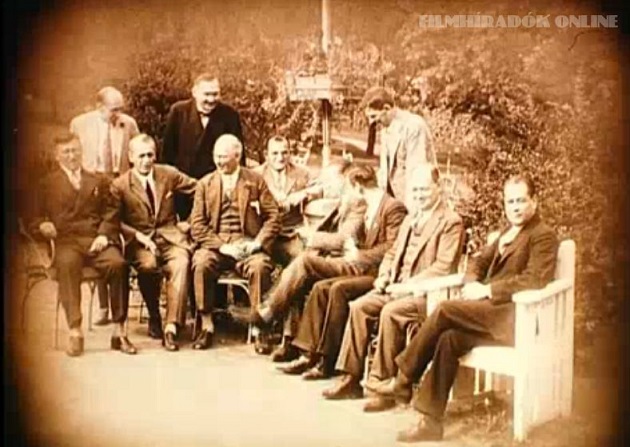
... as well items with footage of Maróczy, Réti, Rubinstein and Tartakower.

(10764)
The group photograph of Budapest, 1896 is fairly well known – see, for instance, page 5 of John C. Owen’s tournament book (Yorklyn, 1994) – but a particularly good version was published on page 793 of the 22 November 1896 edition of Vasárnapi Ujság (with Marco and Maróczy’s names transposed):

(10913)
From page 189 of CHESS, May 1940, in an article entitled ‘Last-Round Surprises’ by S. Tartakower (pages 186-190):

Maróczy annotated his loss to Oskam on pages 101-102 of the Scheveningen, 1923 tournament book published by Bernhard Kagan:
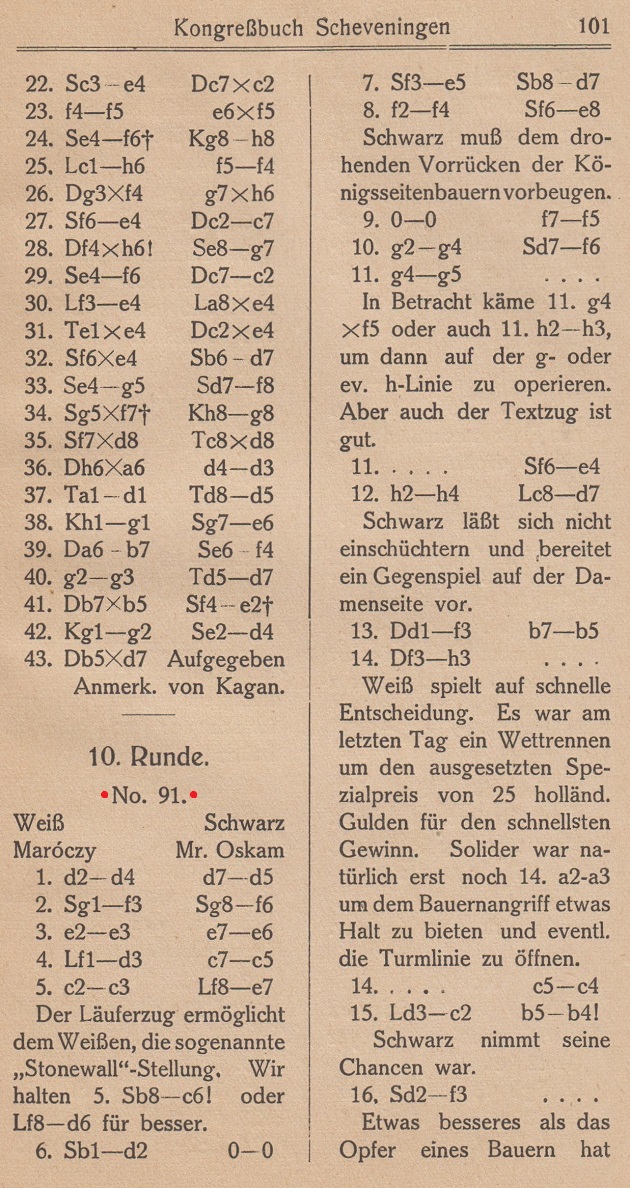

1 d4 d5 2 Nf3 Nf6 3 e3 e6 4 Bd3 c5 5 c3 Be7 6 Nbd2 O-O 7 Ne5 Nbd7 8 f4 Ne8 9 O-O f5 10 g4 Ndf6 11 g5 Ne4 12 h4 Bd7 13 Qf3 b5 14 Qh3 c4 15 Bc2 b4 16 Ndf3 bxc3 17 bxc3 Nxc3 18 h5 Nd6 19 Ng6 Re8 20 Ba3 Nce4 21 Nfe5

21...Nc8 22 Rab1 Bxa3 23 Rb7 Nb6 24 Nxd7 Nd6 25 Nxb6 axb6 26 White resigns.
However, according to pages 104-105 of the tournament book it was another game, Johner v Fick, which won the prize for the first game to end in the final round:


1 d4 d5 2 c4 c6 3 e3 Nf6 4 Nf3 Bg4 5 cxd5 Nxd5 6 e4 Nf6 7 Nc3 e6 8 Be3 Be7 9 Qc2 Bxf3 10 gxf3 Qa5 11 Rg1 g6 12 O-O-O b5 13 Kb1 Nbd7

14 d5 exd5 15 exd5 exd5 16 Nxd5 Nxd5 17 Rxd5 a6 18 Bh3 f5 19 Qc6 [Kf7 and Black resigns].
In the exchanges on d5 a pair of moves was missing from the tournament book, and our game-score above follows what appeared on page 3 of the Nieuwe Rotterdamsche Courant, 4 August 1923, which discussed both games:


(11002)
On page 256 of CHESS, June 1947 B.H. Wood reported on a conversation with Géza Maróczy at Baarn, 1947:


(11025)
From Emanuel Lasker’s column in the New York Evening Post, 2 May 1908, page 9:
‘Maróczy has the emotional nature of the Magyar, and is therefore as variable as his moods. He can play all styles, the highest and the lowest, and neither his upper nor his lower limits have yet been determined. Hence he is somewhat of a riddle, that could be solved only if he pitted himself against the foremost masters in match play, but he resolutely declines to do so. Perhaps he likes to remain a mystery.’
(12136)
A good copy of this photograph would be welcome:

Evening Express (Liverpool), 6 January 1930, page 5
(12137)
To the Chess Notes main page.
To the Archives for other feature articles.
Copyright: Edward Winter. All rights reserved.